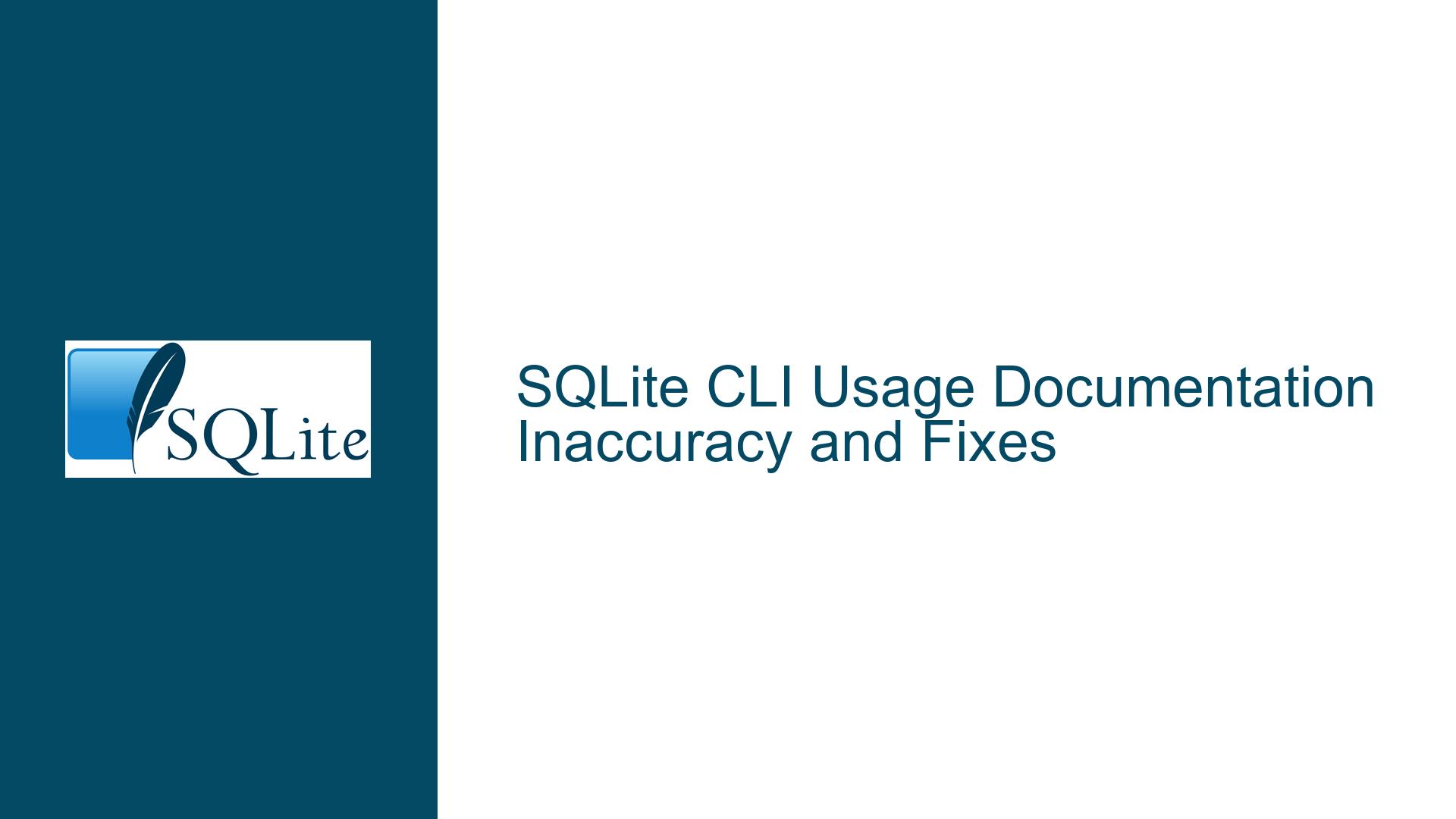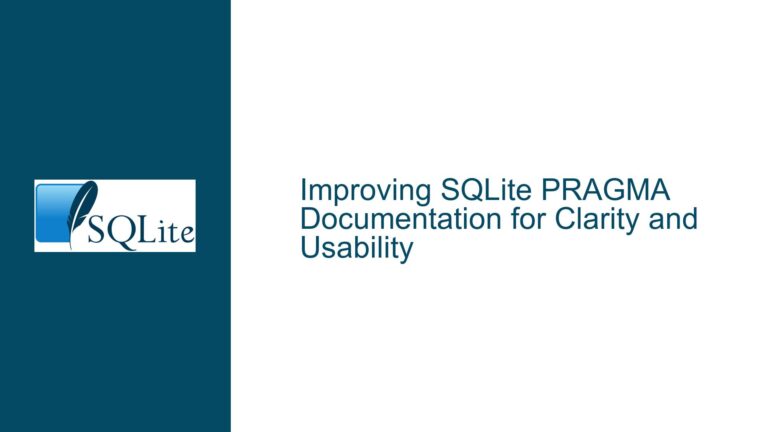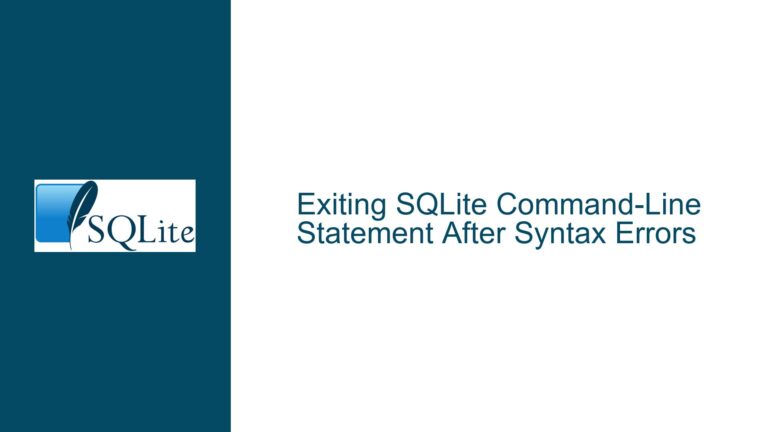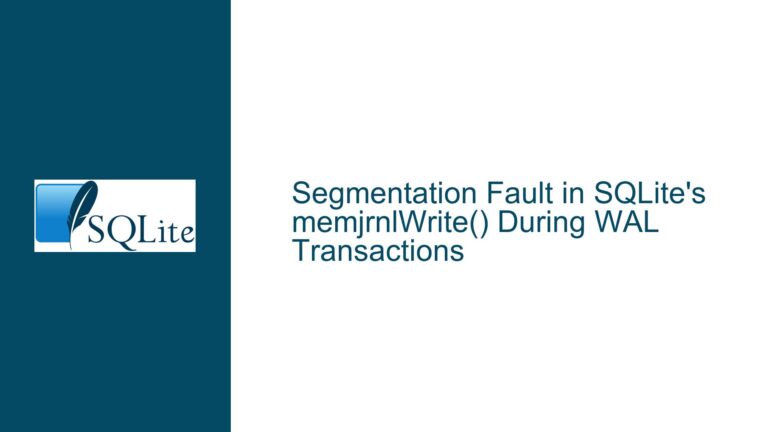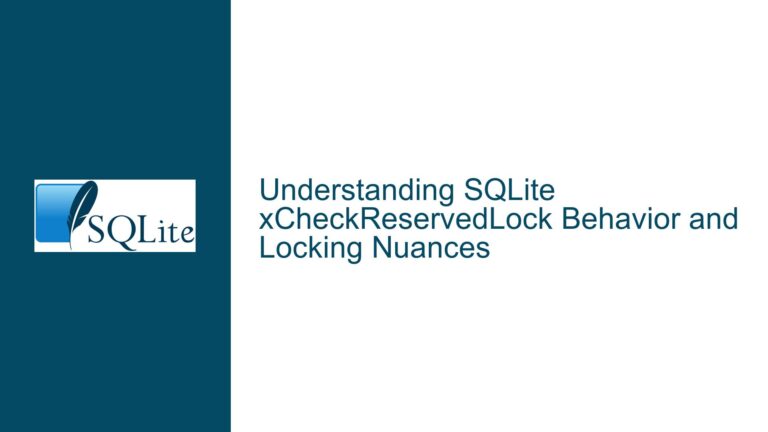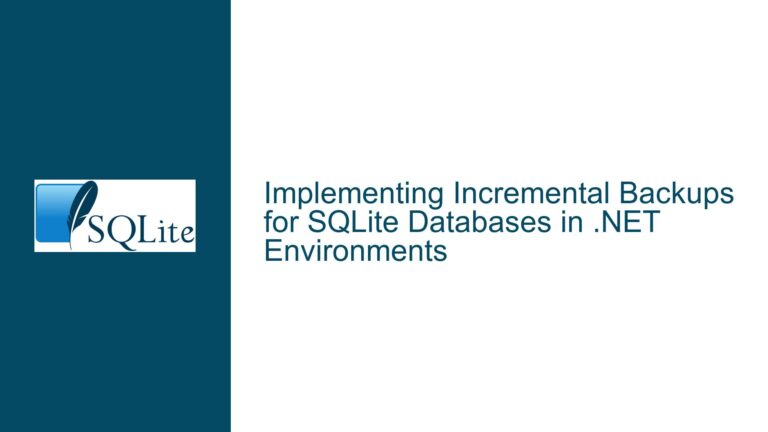SQLite CLI Usage Documentation Inaccuracy and Fixes
Issue Overview: Misleading CLI Usage Text and Argument Handling
The core issue revolves around the inaccuracy and oversimplification of the SQLite CLI (Command Line Interface) usage text, specifically the line: "Usage: %s [OPTIONS] FILENAME [SQL]\n". This line, found in the src/shell.c.in file, is intended to guide users on how to interact with the SQLite shell. However, it fails to accurately represent the flexibility and nuances of how arguments are processed by the SQLite CLI. The current usage text implies a strict ordering of arguments, which is not the case in practice. This discrepancy can lead to confusion for users who rely on the usage text to understand how to structure their commands.
The SQLite CLI is designed to handle a variety of argument configurations, including intermingling options and non-option arguments. The first non-option argument is interpreted as the database filename, while subsequent non-option arguments are treated as dot commands or SQL statements. This flexibility is not reflected in the current usage text, which suggests a more rigid structure. Additionally, the usage text incorrectly implies that the FILENAME argument is mandatory, when in fact, it is optional and defaults to :memory: if not provided.
The discussion also touches on the introduction of a new -- option, which signifies that no more options follow. This option is particularly useful when a user wants to ensure that subsequent arguments are not interpreted as options, especially when those arguments might otherwise be mistaken for options due to their format. However, the implementation of this new option has raised questions about its dependency on certain compiler switches, which may affect its availability in different builds of SQLite.
Possible Causes: Oversimplification and Undocumented Features
The root cause of the issue lies in the oversimplification of the usage text, which was likely intended to make the CLI more approachable for users. However, this simplification has led to a lack of clarity regarding the actual behavior of the SQLite shell. The usage text does not account for the fact that options and non-option arguments can be intermingled, nor does it mention the optional nature of the FILENAME argument. This omission can be particularly problematic for users who are not familiar with the internal workings of the SQLite CLI and rely solely on the usage text for guidance.
Another contributing factor is the presence of undocumented features in the SQLite CLI. The ability to intermingle options and non-option arguments, as well as the default behavior of using :memory: as the database filename when none is provided, are not explicitly documented in the usage text. This lack of documentation can lead to confusion, as users may not be aware of these features and may struggle to understand why their commands behave differently than expected.
The introduction of the -- option further complicates the issue, as its availability may depend on specific compiler switches. This dependency raises questions about the consistency of the SQLite CLI across different builds and environments. If the -- option is not available in all builds, users may encounter unexpected behavior when attempting to use it, leading to further confusion and frustration.
Troubleshooting Steps, Solutions & Fixes: Updating Documentation and Clarifying Behavior
To address the issues outlined above, several steps can be taken to improve the accuracy and clarity of the SQLite CLI usage text and ensure that users have a better understanding of how to interact with the shell.
1. Update the Usage Text to Reflect Actual Behavior
The first and most straightforward solution is to update the usage text in src/shell.c.in to more accurately reflect the behavior of the SQLite CLI. The updated usage text should clearly indicate that options and non-option arguments can be intermingled, and that the FILENAME argument is optional. A more accurate usage line might look something like this:
"Usage: %s [OPTIONS] [FILENAME] [SQL]\n"
This revised usage text makes it clear that both the FILENAME and SQL arguments are optional, and that options can be placed anywhere in the command line. Additionally, the usage text should be accompanied by a more detailed explanation in the documentation, outlining the various ways in which arguments can be structured and interpreted by the SQLite shell.
2. Document Undocumented Features
In addition to updating the usage text, it is important to document the previously undocumented features of the SQLite CLI. This includes the ability to intermingle options and non-option arguments, the default behavior of using :memory: as the database filename when none is provided, and the new -- option. These features should be clearly explained in the official SQLite documentation, with examples provided to illustrate their use.
For example, the documentation could include a section on argument handling that explains how the SQLite CLI processes different types of arguments. This section could include examples of commands with intermingled options and non-option arguments, as well as examples of commands that use the -- option to prevent subsequent arguments from being interpreted as options.
3. Ensure Consistent Availability of the -- Option
The -- option is a valuable addition to the SQLite CLI, but its availability should not depend on specific compiler switches. To ensure that this option is consistently available across all builds of SQLite, the code that defines the zOptions array should be modified to remove the conditional compilation directives that currently surround the -- option. This will ensure that the -- option is always included in the list of available options, regardless of the build configuration.
4. Provide Clear Error Messages and Help Text
In addition to updating the usage text and documentation, it is important to ensure that the SQLite CLI provides clear and informative error messages when users attempt to use invalid or unsupported argument configurations. For example, if a user attempts to use the -- option in a build where it is not available, the CLI should provide a clear error message explaining that the option is not supported in that build.
Similarly, the help text provided by the SQLite CLI should be updated to include information about the -- option and its purpose. This will help users understand how to use the option and when it might be useful.
5. Conduct User Testing and Feedback Collection
Finally, it is important to conduct user testing and collect feedback from users to ensure that the updated usage text and documentation are clear and effective. This could involve distributing a beta version of the updated SQLite CLI to a group of users and soliciting feedback on the clarity and accuracy of the usage text and documentation. Based on this feedback, further refinements can be made to ensure that the SQLite CLI is as user-friendly as possible.
Conclusion
The issues surrounding the SQLite CLI usage text and argument handling are primarily due to oversimplification and a lack of documentation for certain features. By updating the usage text, documenting previously undocumented features, ensuring consistent availability of the -- option, providing clear error messages and help text, and conducting user testing, these issues can be effectively addressed. These changes will help users better understand how to interact with the SQLite CLI and reduce confusion and frustration when using the shell.
